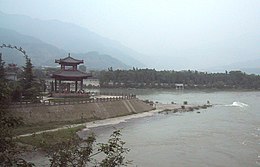Dujiangyans irrigasjonssystem

Dujiangyans irrigasjonssystem (forenklet kinesisk: 都江堰, pinyin: Dūjiāngyàn) i Dujiangyan fylke er en infrastruktur for irrigasjonssystem bygd i 256 f.Kr. i De stridende staters tid av staten Qin. Det ligger ved elven Min (Minjiang) i Sichuanprovinsen i Kina. Vanningssystemet er fremdeles i bruk og gir over 5300 km² land vann.
Historie[rediger | rediger kilde]
Planlegging[rediger | rediger kilde]
I de stridende staters periode var folket ved Minjiangs bredder utsatt for hyppige oversvømmelser. Qins guvernør Li Bing utredet problemet og oppdaget at elven vokste på grunn av det raske smeltevannet fra de nærliggende fjellene som slår breddene når det nådde den langsomme og sterkt siltede strekningen nedenfor.
Den mest åpenbare løsningen kunne ha vært å bygge en demning, men Li Bing hadde også fått i uppdrag å holde elven åpen for militær sjøfart.[1] Derfor ville han bygge en voll for å omdirigere en del av elvens vannstrøm og lage en kanal gjennom Yuleishan for å lede bort overflødig vann til den tørre Chengdusletten.[2]
Konstruksjon[rediger | rediger kilde]
Li Bing fikk 100 000 tael sølv for prosjektet av kong Zhao av Qin og påbegynte arbeidet med et arbeidsteam som skal ha vært på titusener. Vollen ble oppført fra lange pølseformede kurver av vevd bambus fylt med stein kjent som Zhulong[3] holdt på plass av trebente treviter kjent som Macha.[4] The massive construction took four years to complete.[5]
Å grave kanalen viste seg å bli et langt større problem ettersom de verktøy som den gang var tilgjengelige, innen man hadde oppfunnet kruttet, ikke kunne trenge gjennom det harde fjellet. Man måtte benytte en kombinsjon av ild og vann for å varme om å nedkjøle fjellet til det sprakk og kunne taes bort.[6] Etter åtte års arbeid var en 20 meter bred kulvert gjennom fjellet blitt klar.[7]
Ettertiden[rediger | rediger kilde]

Etter at systemet stod klart var det slutt på oversvømmelsene. Irrigasjonssystemet gjorde Sichuan til det mest produktive jordbruksområdet i indre Kina. Li Bing ble høyt elsket, og etter hans død oppstod det en omfattende religiøs kult til hans ære.
Idag er Dujiangyans irrigasjonssystem en stor turistattraksjon og i år 2000 ble det del av Verdensarven.
Referanser[rediger | rediger kilde]
- ^ China Heritage Project. «Taming the Floodwaters». The Australian National University. Arkivert fra originalen 19. juli 2011. Besøkt 22. april 2008. «Li Bing was commissioned to conduct an extensive hydraulic survey to regulate the unpredictable course of the swiftly flowing spring-thaw waters of the Min River that regularly flooded areas and settlements on the plains around Chengdu, and simultaneously ensure that the Min River had a fairway flow through Chengdu, facilitating navigation by military vessels that could service Qin's logistical supply lines.»
- ^ China Heritage Project. «Taming the Floodwaters». The Australian National University. Arkivert fra originalen 19. juli 2011. Besøkt 22. april 2008.
- ^ «Zhulong». Dujiangyan Irrigation System Museum. «It is also called Zhuluo, Zhulou, etc. which is a long sausage-shaped basket of woven bamboo filled with stones used to protect the riverbed or served as a dam. While the Dujiangyan Irrigation Project under the guidance of Li Bing, Zhulong was widely used. It was simple and cheap but effective and has been passé down from generation to generation. Even today it is still widely adopted in flood control.»
- ^ «Zhulong». Dujiangyan Irrigation System Museum. «They are wood tripods used to support a temporary dam to cut off a river, control flood or regulate water, etc. They are one kind of flexible convenient and effective engineering facilities.»
- ^ China Heritage Project. «Taming the Floodwaters». The Australian National University. Arkivert fra originalen 19. juli 2011. Besøkt 22. april 2008. «In 268 BCE, Li Bing is said to have personally led ten of thousands of workers in the initial stage of construction on the Min River banks. The workers made bamboo cages and threw cages of rocks into the middle of the river. It took them four years to complete a water-diversion levee resembling a fish's mouth. When the water reaches Yuzui, the 'fish's mouth,' it is naturally diverted into the inner and outer flows. The inner flow is the diversion channel that leads to Chengdu.»
- ^ China Heritage Project. «Taming the Floodwaters». The Australian National University. Arkivert fra originalen 19. juli 2011. Besøkt 22. april 2008. «Prior to the invention of gunpowder, manual labourers using only drill rods and stone hammers would have taken 30 years to cut through the mountain. Qin military planners required more immediate results, so Li Bing proposed using the expeditious and simple technology of using controlled blazes to scorch the rocks and then dousing them with cold water. The seemingly limitless forest resources of the region at that time – evidence of which is provided by the Shu kingdom period tree trunk coffins recently unearthed in downtown Chengdu – made such an option possible. King Zhao of Qin allocated 100,000 taels of silver for the project.»
- ^ China Heritage Project. «Taming the Floodwaters». The Australian National University. Arkivert fra originalen 19. juli 2011. Besøkt 22. april 2008. «It took a further eight years to cut through the mountain, and the 20 m wide culvert allows the water to flow into the Chengdu Plain. The key part of the project was the diversion gate called Baopingkou that resembles the neck of a bottle, and through this passage, the waters of the Min River could irrigate the Chengdu Plain in perpetuo. In 256 BCE, after 14 years of arduous labour, the Dujiangyan project was completed. That, at least is one received historical account, but it is undeniable that for more than two millennia this irrigation project has been in use on the Chengdu Plain.»
